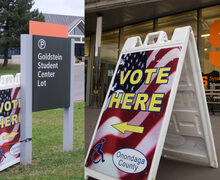SU Drama students criticize department’s progress in addressing racism
Photo by Alex Malanoski, Contributing Photographer / Photo Illustration by Emily Steinberger, Photo Editor
At least 684 people have now signed the document, which includes pages-long accounts of racist incidents students have allegedly experienced or witnessed during their time at SU.
The Daily Orange is a nonprofit newsroom that receives no funding from Syracuse University. Consider donating today to support our mission.
Three months after hundreds of Syracuse University drama students and alumni signed a call to action alleging “pervasive institutional racism” within the department, faculty and staff have begun to implement changes. But some students and alumni remain disappointed.
Organizers sent the call to action, which includes pages-long accounts of racist incidents students have allegedly experienced or witnessed during their time at SU, to the Department of Drama on June 15. At least 684 people have now signed the document.
Though the call to action’s organizers have met with SU Drama faculty at least five times since June to discuss their demands, some current students and alumni told The Daily Orange that the department hasn’t been transparent about its efforts to improve conditions for students of color and seems to lack urgency in enacting changes.
“We heard from the Black students directly and they said nothing has changed, and it seems like a lot of the faculty are treating the changes like bandaids and umbrellas,” said Courtney Rikki Green, one of the call to action’s organizers.
Ralph Zito, chair of the department and a professor of acting, has spearheaded the university’s response to student and alumni concerns.
In addition to meetings with organizers, current students and Visual and Performing Arts Dean Michael Tick, the department has also rolled out extensive diversity and inclusion training for faculty, Zito said. Discussions with alumni organizers and Black students have been difficult but positive, he said.
“They are giving up their time and energy in situations that are painful and challenging,” he said. “That’s an extraordinarily generous act, and I am doing my best to honor that commitment by doing everything I can to keep this conversation moving.”
SU Drama faculty participated in training over the summer to address body shaming, syllabus reform and the ways students of color are treated in the classroom, Zito said. Representatives and guests from SU’s Center for Teaching and Learning Excellence and the Office of Diversity and Inclusion led the training sessions, he said.
The department’s first two faculty meetings of the year will also be devoted entirely to addressing concerns expressed in the call to action, Zito said.
Zito and other SU officials have been receptive, alumni organizer Barbara Woodall said. But she was disheartened to learn that some SU Drama students were not seeing much progress.
“It didn’t seem like all of the professors were on the same page with it,” Woodall said.
Amaan Khan, a sophomore studying theater design and technology, said he hasn’t heard anything from department officials besides statements that meetings are happening. The department could be handling the situation much better, he said.
He hopes SU officials will make it clear in their communications that Black students and students of color are leading change in the department.
Sophomore Soumya Tadepalli has noticed changes in some of her classes. Her introductory theater class, in which she’s a teaching assistant, now features more plays from playwrights who are people of color.
But the department has to be careful to ensure its diversity efforts rise above tokenism, said Tadepalli, who’s studying theatre management.
“The responsibility to educate others about racial issues in the theater shouldn’t always fall on the professors of color,” Tadepalli said. “If a season includes a play with a diverse cast, it should be for the purpose of valuing those student voices, not for checking the diverse play box.”
Faculty seem more open now to admitting wrongdoing when presented with grievances from students than they have in the past, said Candice Hatakeyama, a senior studying musical theater. But some professors have been more active in responding to the call to action than others, she said.
“I perceive no unwillingness on the part of the faculty to make changes,” Zito said. Making sure faculty have the information and tools to make necessary and impactful changes will take work, he said.
The department has agreed to and begun progress toward nearly all of the demands students and alumni made in the call to action, Zito said.
Faculty and department officials are still working to craft an apology from the department to students who are people of color, he said. Demands that required little procedure or group approval have moved forward.
Effective this fall, the department’s senior showcase will be open to all graduating senior performance majors. Faculty will also remove “colorblind casting,” a term for casting without considering an actor’s ethnicity, skin color, body shape, sex or gender, from the department’s vernacular, fulfilling another one of the organizers’ demands, Zito said.
The department will also require that the majority of visiting guests be artists who are people of color. Zito will only approve requests for one guest if the guest is a person of color, and if faculty want to bring more than one guest to campus, the majority of the group must identify as people of color.
Zito has approved 32 guest artists, guest instructors and class visitors for the fall semester, 30 of whom identify as people of color, he said.
The department has also stopped referring to itself as a “safe space” for students on its course materials, replacing it instead with “brave space.” The change is intended to more accurately portray the department’s culture, Zito said. In the past, students disagreed with that language because they felt that the department wasn’t actually safe and supportive.
Demands related to curriculum changes, new hires and disciplinary action for faculty could take considerably longer to enact, Zito said.
Alyssa Smith, another alumni organizer, understands why some changes might take longer to implement, but SU’s protocols still frustrate her. Organizers were surprised to learn how long the hiring process can take, she said.
The call to action demanded that any faculty member who is removed for racist behavior be replaced by a hire who is a person of color, and that faculty of color make up 50% of the department by 2025.
“It wasn’t met with resistance, but it’s certainly closer to impossible than possible,” Smith said.
The time-consuming procedural requirements surrounding hiring and curriculum development can make it seem like SU officials are not moving with urgency, said Casey Boykins, who also helped organize the call to action.
“I think a lot of students were upset and then wanted to see changes immediately, and I think we were all disheartened to learn how long we might be waiting for some of these changes to happen,” Boykins said.
Figuring out how to best help current students and navigate complicated university policies and procedures has been challenging, Green said.
“It is kind of like pulling teeth sometimes to get information and figure out the avenues we need to go through to help out and create change and advocate for the students more,” she said.
One of the fundamental ways faculty can immediately communicate a new culture in the department is through their day-to-day interactions with students, Zito said. Some faculty will be quicker to adapt than others, he said.
“I have received feedback that some attempts at that interpersonal change and communication in the initial go around have not gone well,” Zito said. “I think making those interpersonal changes is more challenging long-term but obviously equally necessary and equally prioritized.”
Going forward, students and alumni said they hope the department will be more transparent about the progress it’s making and the resources that are available for current students.
Tadepalli would appreciate email updates about actions the department is taking to address the call to action. Hatakeyama hopes the department will provide more concrete information and timelines about the hiring process and other procedural obstacles to enacting demands.
Green hopes the call to action’s organizers will eventually no longer be needed — that drama faculty and staff will listen to students’ concerns and advocate for them.
“The ultimate goal for the work we’re doing is that we be deemed obsolete,” she said.
Published on September 9, 2020 at 11:17 pm
Contact Michael: msessa@syr.edu | @MichaelSessa3






